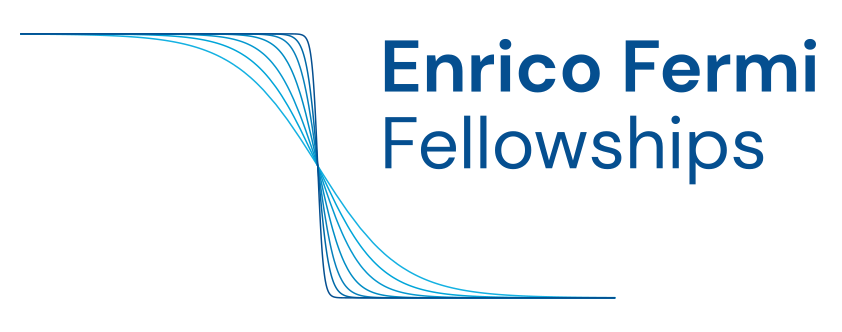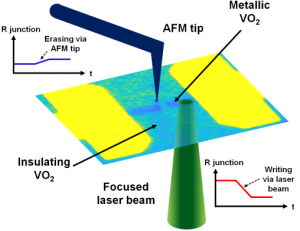The core of my Enrico Fermi Fellowship project is to understand and control the electronic “avalanches”—rapid, spontaneous switching events—that occur during the phase transition in VO₂. By precisely controlling these electronic avalanches, we can develop materials that have reliable neural behavior, paving the way for energy-efficient, brain-inspired computers. At LPEM-ESPCI in Paris, under Professor Alexandre Zimmers, I will enhance our optical microscope setup to capture high-resolution images of these transitions, triggering them with heat, electric fields, and lasers. Analyzing these images will help us understand the fundamental physics that govern these phenomena.
A vanadium dioxide (VO₂) thin film (shown in blue/green false colors) is positioned between two gold contacts (yellow). A micron-sized metallic path (dark blue line) is created through laser writing by locally heating the film. The metallic path is then partially erased on a submicron scale using an atomic force microscope (AFM) (light green gap) by locally cooling the film. The red and blue curves represent the schematics of the resistance drop and rise during the laser encoding and AFM nanoscale erasing of the metallic path, respectively. This dual-process resistive fine-tuning enables the creation of controllable synaptic weights in neuromorphic circuits [Fang2024]. See video: https://youtu.be/WsqjTZ1U7Y4
Complementing this experimental work, I am simultaneously pursuing a theoretical understanding of the underlying physics. Collaborating closely with my advisor at Purdue, Professor Erica Carlson, we employ theoretical modeling techniques, such as the random field Ising model—a framework for understanding phase transitions in disordered systems—to interpret experimental data and predict the behavior of these quantum materials. By bridging theory and experiment, we can gain deeper insights into how disorder, strain, and external forces influence the insulator-to-metal transition in VO₂. This interdisciplinary, cross-training approach ensures our theoretical models are rigorously tested by real-world experiments.
My ultimate goal is to advance the development of scalable, energy-efficient computing technologies that help mitigate the global energy demands of AI. This project uniquely integrates experimental precision with theoretical insights, providing me with cross-training experience essential for addressing complex problems in modern science. Furthermore, through exploring how complexity emerges in quantum materials, this project can shed light on fundamental questions about the nature of intelligence itself. Understanding these phase transitions not only helps build more efficient computers but also deepens our insight into how intelligent behaviors might naturally arise from complex physical interactions, creating fascinating connections between physics, neuroscience, and even philosophy.




